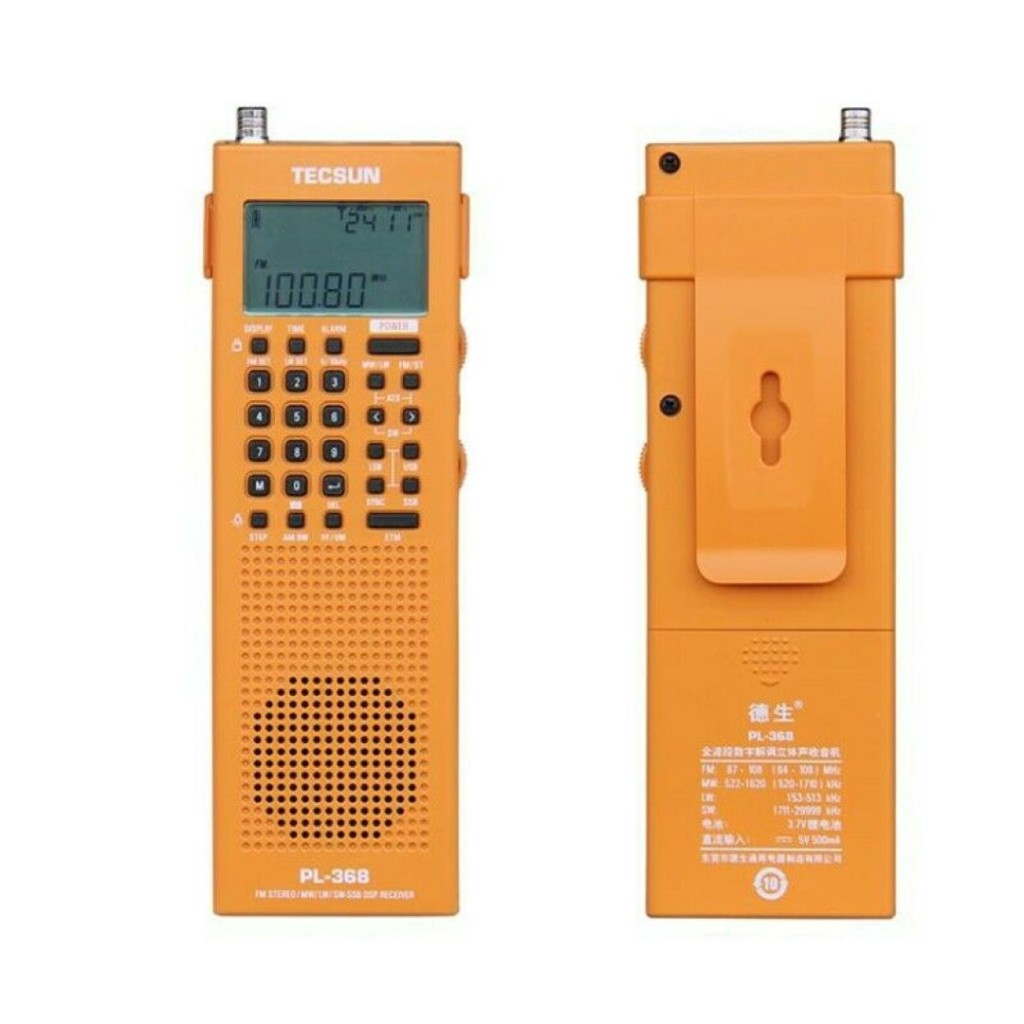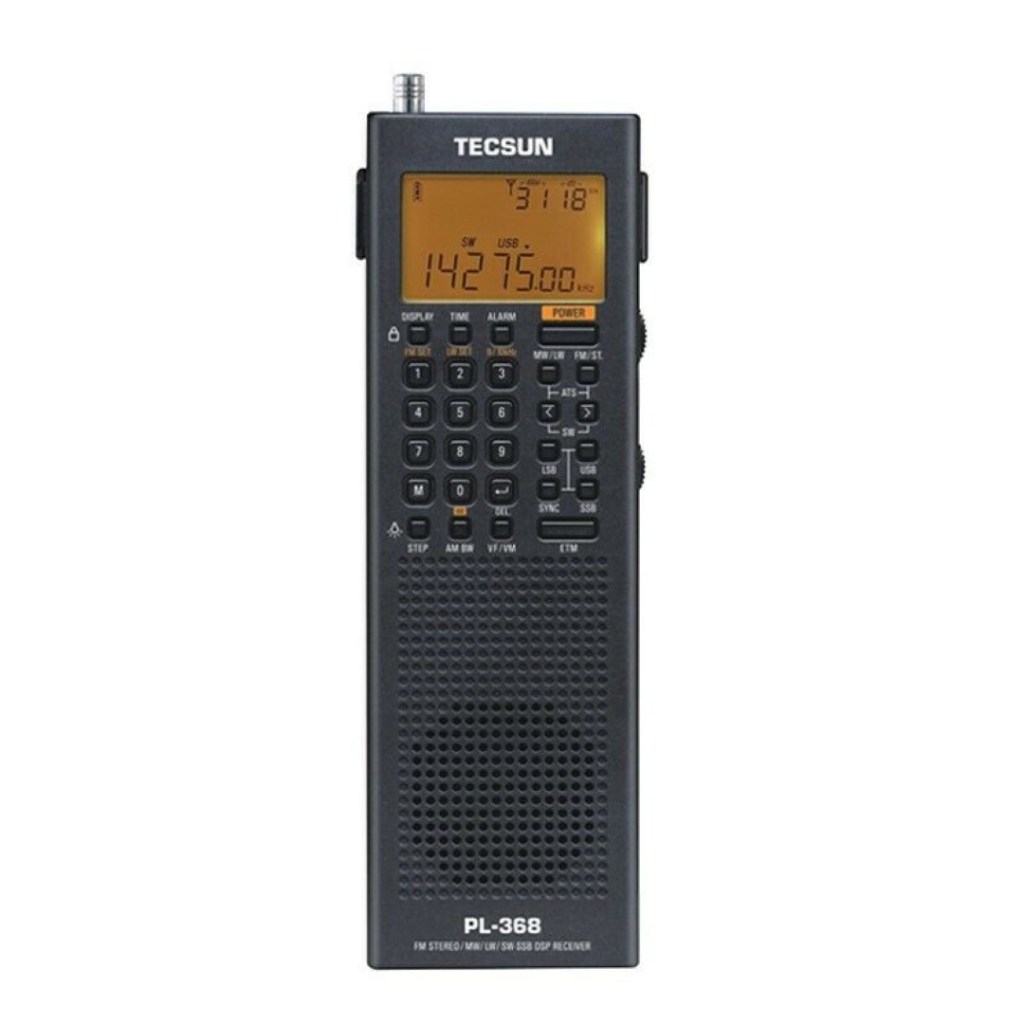Tecsun PL-368 Handheld Multiband Radio

The new Tecsun PL-368 is the third major version of this vertical, hand-held “walkie-talkie-style” radio. It is of course not a walkie talkie but rather an unusual multiband receiver. Initially there was the PL-360/CountyComm GP-5 DSP (which seems to still be available from some sources). The next version (also still available) was the PL-365/CountyComm GP-5-SSB which added a few improvements along with SSB. Now a real game-changer…this latest version adds a keypad for direct frequency entry, elevating the PL-368 to a much higher level of usability. Anon-co.com advises they are selling it for $73 w/o battery with free shipping or approximately $84.45 with battery plus standard shipping. You can contact them for shipping options.

If you’re not familiar with this family of radios I strongly recommend you read my earlier report on the PL-365, which will explain quite a bit about the hand-held concept of all of these radios.
Read The Tecsun PL-365 Review:
Let’s begin with a look at the PL-368’s Hidden Features:
PL-368 Hidden Features (Updated)
Switch between internal ferrite rod and whip on AM (MW & LW)
1. Select the MW or LW band.
2. Press and hold key ‘3’ for about 2 seconds.
When the display briefly shows “CH-5” this means that the device is set to MW/LW reception using the telescopic antenna. The display shows MW (or LW) and SW on the left side of the screen. Press 3 again – When the display briefly shows “CH-A” this means that the device is set to MW/LW reception using the internal ferrite antenna. The display shows only MW (or LW) on the left side of the screen.
Adjusting the maximum volume level
Select the frequency band, then press and hold key ‘7’ for 2 seconds until a number is displayed. At this moment, rotate the [ TUNING ] knob to adjust and press the key ‘7’ again to save and exit.
Display Firmware Version
In power-off mode, press and hold [ VF/VM ] for 0.5 seconds until all characters on the display are shown, then wait a few seconds until the firmware version is briefly displayed in the middle of the display. (Actually it’s at the Top Right. Also note there are some symbols which are not relevant to the PL-368, such as ones that relate to Tiff cards).
Extend SW-range for European setting (1621-29999 kHz)
1. In power-off mode, press and hold the [ 3 ] key to set the MW tuning steps to 9kHz.
2. Select the SW band, and then press and hold the [ 5 ] key for 10 seconds to enable/disable the SW frequency extension.
The starting point of the SW frequency range will become 1621 or 1711 kHz.
Adjust SW-ETM Scanning Speed
1.With radio On press and hold #6 until display reads 1 through 4, with 4 the slowest.
Set FM De-emphasis
With radio on press and hold #5 to toggle between 75 (US) and 50 (Europe)
Calibrate LSB/USB
In each SSB mode (do separately for USB and LSB modes), tune to a strong MW or SW signal, press Step key to enter Fine Tune mode and zero beat as well as possible, then press nd hold the appropriate USB or LSB button until the backlight flashes twice.
We now have the Owner’s Manual for download below:
Specifications & Features:

Frequency Ranges:
LW:153 – 613 KHz
MW: 520 – 1720 KHz / 522 – 1620 KHz
SW: 1711 – 29,999 KHz
FM: 64/76/87/88 – 108 MHz
Tuning Steps:
LW: 9 kHz, 1 kHz – Sync: 9 kHz, 1 kHz, 100 Hz – SSB: 9 kHz, 1 kHz, 10 Hz
AM: 10/9 kHz, 1 kHz – Sync 1 kHz, 100 Hz – SSB 10/9 kHz, 1 kHz, 10 Hz
SW: 5 kHz, 1 kHz – Sync: 5/1 kHz, 100 Hz – SSB: 5 kHz, 1 kHz, 10 Hz
FM: 100 kHz, 10 kHz
Memories (Excluding ETM Memories):
LW: 100
MW: 150
SW: 300
FM: 100
SSB: 100
Sync: 100
Synchronous detection Lock range: +/- 1 KHz
Power: BL-5C 3.7V Li-Ion Battery/Charges via standard Micro USB Jack 5V/500 ma
Size (approx.): 6.4” x 2” x 1” / 162mm x 53mm x 26mm
Weight With Battery (approx.): 4.6 oz / 130 g
In The Box: The PL-360 comes with a carrying pouch, stereo earbuds, a USB charging cable and an instruction book. (Anon-co-com supplies an English manual). Some eBay sellers are providing a Chinese manual so it pays to check.

First Impressions: The first thing I noticed is that the radio is lighter than its predecessors due mainly to its use of a lightweight BL-5C Li-Ion battery in place of 3 AA’s. The numeric keypad is a miniaturized version of that found on several other recent Tecsun models. Indeed, for someone who has used other Tecsuns the family familiarity makes getting to know the PL-368 very straightforward, even though there are some very real model-to-model differences. If you read my earlier review mentioned above you already know that these radios were tactically designed for a very specific type of use…handheld…its shape does lend itself to single-handed use.
In addition, its slim design necessarily means those front panel buttons are smaller and closer together than on larger radios. This is both a blessing and a curse depending on the user and manner of use. On one hand, the slim shape is a necessity to make one-handed use easier, but on the other hand the smaller buttons are a bit harder for those of us who are a bit clumsier. I don’t mean this as a slight in any way, just that this radio is a very specific design for a very specific type of use. For one-handed use it is a unique solution and you shouldn’t expect it to be a replacement for a more typical radio which you might sit on a table or desk.
Performance: Nevertheless, the PL-368 is a strong performer for its size and price. The first thing I tested was SW sensitivity on the whip antenna and it ran neck and neck with Tecsun’s PL-330 which was expected. I also compared it with admittedly more upscale radios like Tecsun’s PL-990, PL-660 and Sangean’s ATS-909X2 and the larger radios were a bit more sensitive to weak daytime SW signals. As the signal would fade to noise on the PL-368 there were still traces of listenable reception on the larger radios…again, this was to be expected. I will say though that, for signals it did pull in, voices were very intelligible on the PL-368 due to its very clear audio…this radio is meant for voice clarity (not fullness) so for readability the PL-368 gets high marks. Of course, you can get fuller audio through earbuds. I did note some soft muting or DNR which was evident as volume surging on very weak signals which were way down in the noise, similar to the PL-330. At least the threshold seems to be set very low so that anything you might actually listen to should be above that threshold but if you are searching for faint singles which are barely readable it is a bit annoying and it is too bad there is no Hidden Feature to turn it off completely.

SSB was very good by portable standards. I found it easy to get natural sound with the 10 Hz Fine-tuning steps. It is true that the PL-368 (at least in its current firmware version), lacks the USB calibration feature found on several other Tecsuns but I don’t consider this a serious issue since proper tuning seemed to be very close to the correct frequency. Also, I’ve found that on the Tecsuns that do offer this feature, as cool as it is, it is not a panacea because you have to recalibrate if you make big frequency changes, such as changing meter bands on SW or going from SW to MW. It is handy if you customarily come to one frequency range but at other frequencies it usually has to be redone.
AM: Once again, using the supplied plug-in ferrite rod antenna, the PL-368 was surprisingly good on AM and approximately matched the PL-330, and was only a hair behind the larger radios mentioned earlier. This is a clever way to use a larger antenna than that which would fit inside the narrow case, and if you’re not going to use AM it can be removed to keep the radio smaller. And although it is easy to rotate such a small radio to point its internal ferrite in the right direction, there is something cool about rotating that antenna while the radio remains facing you…it is very easy to hear the nuances of rotating the antenna this way. Without the plug-in ferrite antenna AM reception is limited to strong local signals.
Synchronous Detection: As in other Tecsuns (other than the PL-660/PL-680) the sound quality in sync mode is needlessly filtered and unpleasant. Sync locks well enough and does provide enhanced sideband suppression and improvements in reception during selective fading but I find the sound so restricted that I prefer to leave the sync off. As an alternative to sync, I found ECSS tuning mode was very usable on this radio.
FM: FM was the biggest disappointment on the PL-368 and was somewhat of a surprise. Of all the radios I compared it with, the PL-368 was a bit less sensitive and noticeably less selective. There were several closely spaced stations which I could listen to reliably on the PL-330 but which had severe interference on the PL-368. The larger radios fared even better. The sound of FM stereo in earbuds was good but since the reception was weaker I would have to say this is not going to be an FM lover’s best choice.
Proximity/Hand Capacitance Effect: I have noticed this with several radios in the past so I think a small refresher might be helpful. Most common with smaller radios, your hand acts as an antenna or artificial ground (counterpoise), such that when you grasp the radio its reception changes…usually it gets stronger. However, this effect not only varies with different models of radio but also with frequency and the specific local conditions. I noticed that with the PL-368 on one or two AM stations the reception actually improved when I set the radio on a table and let go of it, something I have never seen before. With some signals they did get weaker when I let go of the radio but with many other stations there was no or very little effect. I moved to another location and the effect seemed to be much less. Why did this happen? It’s caused by random effects in the area immediately around you and the radio…it is unpredictable, but most smaller radios will exhibit this effect here and there and it seems largely unavoidable.
Conclusion: As I described earlier, the PL-368 is an unusual radio, designed primarily for hand-held voice communication and as such, the small speaker offers outstanding clarity and intelligibility rather than a full, warm sound you would expect from a larger radio. In such use it offers very good AM/SW and SSB performance and its numeric keypad makes it far more user friendly than the previous versions. Your decision as to whether the PL-368 is the best fit for you should be based primarily on this type of use, rather than on small details of performance. For example, to choose between the PL-368 versus the PL-330, the way you intend to use the radio should figure most prominently in your decision. For mobile use as a handheld it is almost without peer. For use around the house, other models might be a better choice. But in its class, it is a great little radio.
Recommended!
You must be logged in to post a comment.